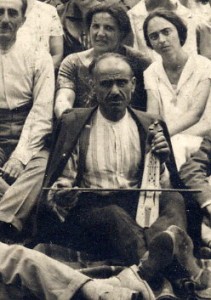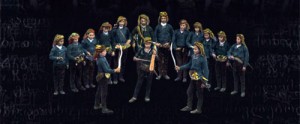An Article By Th. Petrides
The Pontic lyra is often called by its Turkish name Kementsie. The latter term which is Persian in origin meant bow and is used in Turkish to indicate a small bowed instrument, the –tsie (–çe) being the diminutive suffix. In the past, the term Loύra was also used. The ou reflects the sound of the Greek letter ‘ypsilon’ pronounced as an ‘oupsilon’. The origin of the Pontic lyra is still a debatable issue. It has not even been established yet, when this particular form of lyra appeared in Pontos
Most folk fiddles (1) ranging from Southeasten Europe to the Indian sub-continent are played by the lateral pressure of the finger nails of the player’s hand against the strings with the instrument generally being beld facing outwards. Exceptions to this are some ‘primitive’ fiddles played by ligt pressure of the pads of the fingers upon the strings as is also done with some lyras which have the third or even the second string positioned in such a way so as not to allow the easy insertion of the finger between the strings and the spike fiddles, and there are those lyras whose strings are depressed onto the neck of the instrument by the player’s finger pads in the way violin strings are pressed such as an unusual type of Dodecanesian lyra with four strings, the large Cappadocian kemanes, and the Pontic lyra. It may be that the old dancing master’S kit or pochette fiddle (2) one form of which outwardly resembles the Pontic lyra, was adapted and developed later in isolation in Pontos led to the present form of Pontic lyra (3). On the other hand, the Pontic lyra may be result of the natural development of an instrument which had, at once time, an elongated water gourd for its body. Compare the from south Afghina with the Pontic lyra (4).

Pontic Greek kemenche player, Greece
The center of lyra playing activity seems to have been the district of Trapezounta and the contiguos areas of the districts to the west and east of it as well as to the south, i.e. Kerasounta (T.Giresoun), Rizoύnta (T.Rize), and Khaldia whose main town was Arghyrόpolis (T.Tzioumoύskhane-Cümüşhane). As one moves west past Tripolis (T.Tirebolu) towards Kerasounta, the number of lyra players begins to decrease and the lute as well as the violin (keman) and tambourine (tephi) begin playing a more important rple in Pontic music. Further west into the districts of the Kotyora (T.Ortoύ) and before reaching the town of Samsoύnta (T.Samsoύn) the lyra has virtually diasappeared so that Paphra, whose inhabitants were Turkish speaking Pontics, one finds the violin (kemene), the clarinet(girneta), lute (oύti), and bass drum (daoύli) as the main musical instruments, Sinόpe and its environs is not usually considered as a ….in recent tradition.
Moving east of Trapezoύnta, the picture is much the same. After Rizoύnta, the lyra being facing competition from the bagpipe (Pontic angelon or angόpon and touloumpan or touloumpon; Pontic and T.touloum). In recent history, Rizoύnta has replaced Batoύmi, which is across the border in the Soviet Union, as the capital of this eastern district formerly called Lazistan. This district, now called Tsioroύkh (T.Çoruh), has more of a connection with the Caucasus and places like Batoumi, Sokhoumi, Sόsi, and other towns further north along the Black Sea coast to the Kuban which fature music played on the clarinet, violin, and davoli (a medium-sided two headed cylinder drum played on one of its heads with both hands). The Pontic lyra was taken to the Caucasus in the last half of the 19th Century and the first quarter of the 20th Century by both Pontic immigrants and refugees.
korphe (tepe)=pegbox tip (Gr.top)
kephali=pegbox (Gr.head)
otl.=tuning pegs (Gr.literally= ears)
ksiliki=nut (Gr.litle piece of wood)
ghodika=neck (Gr.literally=throat)
ghlossa= fingerboard (Gr.literally= tongue,krabbita=cravat, spakre or spoleri= literally, embroidered apron related to the Italian- back of a chair)
skaphe= main body of instrument (Gr.literally=throug,i.e. that which is dig out)
skepasma=face (Gr.literally_cover, T.kapak =cover)
rasia= ack, also plati=back
rothomia: sound hole (Gr. Literally=nostrils) also skolekia= horos or phidhia=snakes
kordhokrites= bridge (Gr.lit.chord, i.e. string bearer) also gaidodri=donkey, and kavalos=pack horse
oura= end string bolder (Gr.lit.tail) also Gr. Palaistes= lit. Wrestler. Gr./T.pekhlivan(os) =wrestler, Pallikar=warrior (root of L.origin); psari=fish
ta trypia= little sound holes
maghoula= sides- of trough (Gr.lit.cheeks)
stouliri= sound post (Gr.stylari, stylos=post)
kordhes (3) = three metal strings (Gr. Chord, i.e. string a. Psili (T.zil) = high pitched, b.mesaja= middle, c. Khonhri (T.khaba-kaba) =low pitched
toksir= bow
trikha of mallia = horsetail of bow
stoldhia (Greco- latin plodmina) = ornnamentation on the fingerboard
The southern extent of the Pontic lyra was in Khaldia where it was comes into contact with music played on the zourna (shawn) and dauli (bass drum) combination. One should keep in mind however, that the music most typical of Pontos is that which is associated with and played on the Pontic lyra. Second to the lyra was the toulum. For one to make a stalement generalling the line of demarkation between lyra players and toulum players based on the differentation between mul and fruit tree growers verses shepherds is difficult to support in view of so many shifts of population in Pontos. For example, despite the fact that lyra playing was highly developed in Madrodka as far south as Cappadocia side by side with the larger Cappacian lyra (kemanes) and the violin; it was taken there by immigrant workers.

Traditional Pontic folk dance horon
The dances which seem to be most deeply rooted with the main area of Pontic lyra playing, the district of Trapezounta and contiguous areas of the districts bordering it, are as follows(5).
Tik Khorontikon (6) = the upright of the dance, i.e. the upright section in respect to the dance. Dik (tik) in Turkish means upright and refers to the pausing step used in the dance, hence:
Tik Monόn (sinle) 5/16 (3.2) and Tik Dhiplόn 5/8 (3.2) coupled with their varients based on manner of execution –Ghalenόn (calmly), Langevton (lunging or leaping), Sto Ghonatόn (knee bending), Ston Topόn (in place, on the spot).
Sera 7/16 (4.3) or (2.2.3) which reputedly gets its name from a stream called Sera that flows past the town of Platanos (T.Bulat or Pulathane) located on the coast twelve kilometers west of Trapezounta and its slower version Atrepat 7/8 (4.3) or (2.2.3), the latter getting its name from Aktsiabt (T.Akçaabat) the Turkish name of the town Platanos which which is the capital of the kaza (eparchy) of Akçaabat; related dances are Tromakhon (T.Titreme Horonu) and Lazikόn (Laz Horonu).
Pitsiak- oin (T.biçak – Gr.makhaira =Knife +T.oyunu _ Gr.khoros =dance) 2/4 (T.Pitsiak Horoni and Pitsiak Oini). A. Dance for two men face to face.
Tryghόna (Gr. Dove- a girl’s name) 2/4 also called Anapodha because of its clockwise direction. (Almost all Pontic dances travel counter- clock wise)
Omal, i.e. Omal Monόn (Gr. Omalos =smooth + monόn = single) 9/8 (2.2.2.3). Because of the confusion of terminology, I will give the names of a couple of tunes as examples of this dance: “Omallia”, “Lemona”, and “O Ghifnmes”, “ Monoghianmes”.
Dhipat, i.e. Omal Dhipat (Gr. Dhipat =two step) 9/8 (2.3.2.2). Examples of tunes for this dance are “O Akritas” and “To Philieman” (2)
One dance that came to be popular in the district of Kerasoύnta is the Omal Dhiplόn (Gr. Dhiplon= double) and is popularly known as Omal Kerasounteiko. Other names for it are Empropis (Gr. Forward and backward) referring to the slight turning of the dancer’s body forwards and backwards to the counter-clockwise direction of the dance. Yet another name is “Eba- Evgha” (Gr.in and out) fot the same reason above. The obvious links between Kerasoύnta and Trapezoύnta are Tripolis and Koralle (T.Görele or Kiorele). The town of Kerasoύnta was noted for its trading activities and its merchant marine whereas Trapezoύnta was not only a commercial center but was the capital of Pontos and its cultural and educational center.
Kotsangel (T.Kozangel; also Kortsangel and Katsangel) 7/16 (3.2.2). This is a winding dance traditionally danced at the end of wedding festivites.
Mόntsonos. A dance closely connected with Matsouka.
Thymighman ¾ (also Thymisman) Note that the rhytm of this dance differs from that of the one from Kars.
The dances performed in the kaza (eparchy) of Kerasounta were as follows:
1. To Langevtόn (T. Atlama Horani)
2. Eba Evgha
3. To Syrtόn
4. To Nakhtsi
5. O khoros Tes Nyphes
6. Ta Kiotseghikia or Kiotseklika – for couples, from Köçekika (T.köçek =dancing boy) used for somewhat improvised “oriental” dance.
7. O Todourmas or Tontourmas or Toutourmas
8. Kotsangel (T. Kozangel)
9. 9.”O
10. Matroukatika (Omal)
11. “To Melon” (Omal)
12. “Khopa Khopa” (Khorontikόs or tik, i.e. Tik Khorontikόn)
13. “Tamaka” (Tik of Kotyora)
14. “Ka Ela” (Tik)
15. (The steps of the omal and the Dhipli are the same.
Kots 7/16 (2.2.3)or (4.3)
Armatsioύk or Almatsioύk 6/8 (3.3)
Ghiamoura or Ghemoura 6/8 (3.3.) also 7/8 (2.2.3) named after the area south-east of Trapezoύnta
Palpoύrt 10/8 (3.2.2.3) named after Baypurt (Bayburt) south east of Trapezoύnta in Erzurum
Meliitsa also known as Kokkinόghle 2/4
Titara 2/4.Tzantzara
Dances that seem to have close connection with the eastern part of Pontos and appear to have been linked not only with Kars, but with Georgia as well are:
Tamasian (T.Tamaşa) 6/16 (3.3)
Tasin (T.Taş) 6/16 (3.3). The term may mean teeth, therefore it might refer to a figure in the dance where the dancer picks a handkerchief up with his teeth. Often danced at weddings.
Siamil (T.Şamil or Şeyh Şamil Oyunu) 6/16 (3.3)
Lezginka (T.Lezginka or Lezgi) also known as Kazaska 6/16 (3.3)
Kiourtziac (referring to Georgia =Gurgea; R. Gruzia). Meteritsa
All these Georgian/ Caucasian dances are solo or couple dances.
Dances which differ from all those mentioned are ones from the area of Nikόpolis (T.Şebinkarahisar, i.e. Şerkikarahisar = East Black Fort), i.e.
South Pontos:
Outsisi (Outsiaiak – To Uçayak = Sta Tria) 2/4
Nikopoleitkon Omal 9/8 (2.2.2.3)
Epan Khoro (T. Omύz, i.e. Epano stom ‘Omo Khorό) 5/8 or 2/4
Garasaretkon (Garasare) 2/4. The name is from Kara(hi)sar. It s related the Karslidhikon Omal.
It was actually Khaldia that was considered South Pontos. Its center was Arghyrόpolis, i.e. Tzioumouskhane (T.Cumuşhane) and was directly south of Trapezounta. Of all the dances already mentioned, those which seem to be closely connected to the area are as follows:
Arghyropolitkon 2/4
Tsimeritikos (from Tsimera – Tsimarika) 5/8 (2.3)
O Lazikόs (T.Laz Horonu) 7/16 (2.2.3) apparently, the best dancers came from Kromne.
Titara 5/8 (2.3) and a varient in 9/8 (2.2.2.3)
There were dances that had general names as for example: Kyklios Khorόs and Khorόs Eis Dhiplo Bhema which were found in Kromne.
To recapitulate, one must keep in mind that Pontos was a fairly large region which reflected the movements of people into and out of the area. This immigration and emigration was especially apparent as one moved away from the central area of Trapezounta itself and the contiguous areas around it. This also was the area most intricately connected with lyra playing and where most of the dances which are now thought of as pan-Pontic are believed to have originated. One must also remember that a dance that was called by a specific name in one place was not necessarily the same dance which used the same name in another locatio. In adition, there are the variants of a dance within one region. All this makes it quite difficult to reconstruct what the dance and lyra situation was like in Pontos.





